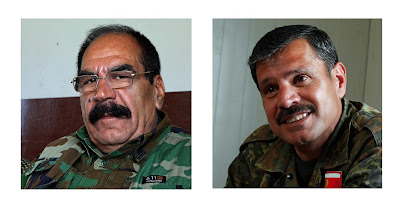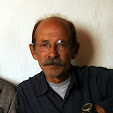 |
| Sinjar City |
The destruction on the south side of Sinjar Mountain was utter. This was Daesh's first target in early morning blitzkrieg on August 3, 2014 which sent thousands of Yezidis up the steep slopes of the mountain to escape. Many made it; many did not. It was here that Daesh murdered, kidnapped, and defiled with unbridled abandon for a year and a half. They still control much of the area, but Sinjar City and a narrow band along the foot of the mountain was militarily retaken in December, 2015. I returned, accompanied by Gharbi and two soldiers from Hayder Shesho's Ezîdxan Forces. It was here I would see more destroyed Yezidi shrines.
The Kurdish and Yezidi armies failed to unite following their conquest in the north. It was the YPG, the Kurdish army from Syria and PKK affiliate, that was the first to respond to the attack, quickly opening a pathway of escape to Syria for the Yezidis stranded on the mountain. Soon the PKK, the Kurdish separatist army from Turkey, arrived. Finally there was the Kurdish Democratic Party's (PDK, the Kurdish acronym) peshmergha which engaged in the fight after initially abandoning the Yezidis to Daesh. It is a dizzying soup of acronyms and identities. The flags were many, the reasons not: Staking claims and legitimacy. And meddling all the while were regional and international political forces.
 |
| Qasim Shesho and Hayder Shesho |
Qasim Shesho ultimately allied his Yezidian army of 8,000 with the PDK's peshmergha, flying the Kurdistani flag. Many Yezidis would not accept the partnership with those they blamed for their plight, so Qasim Shesho's nephew Hayder Shesho formed an independent army of 2,000 Yezidis under their own flag. The relationship between the two is amicable. The YPG and PKK, having spilled blood in the liberation of the north, formed their Yezidian units and have not left.
[Update: On 17 April 2017 Hayder Shesho formally allied his army with Qasim Shesho's and the PDK peshmergha. At the same time he formed a new independent political party, splitting from the PUK, the other major party in Kurdistan.]
[Update: On 17 April 2017 Hayder Shesho formally allied his army with Qasim Shesho's and the PDK peshmergha. At the same time he formed a new independent political party, splitting from the PUK, the other major party in Kurdistan.]
 |
| PKK Memorial to their martyrs |
The situation reached a flash point in March 2017 when the YPG and peshmergha armies fought in the town of Khanisor. Yezidis killing Yezidis. Both sides retreated to rationality before the situation escalated.
As the parochial consequence to me, concerns about Daesh were secondary to the relationships between the flags. I was accompanied by Hayder Shesho's men because he had a better relationship with the PKK who controlled some of the areas we had to pass through. The irony of proximity was stark, hilltop bunkers of competing flags within tens of meters of one another, and checkpoints separated by less than a kilometer. There was no hostility between them; they were merely soldiers.
[Update: On 25 April 2016 Turkey conducted airstrikes against YPG and PKK postions in the Sinjar.]






No comments:
Post a Comment